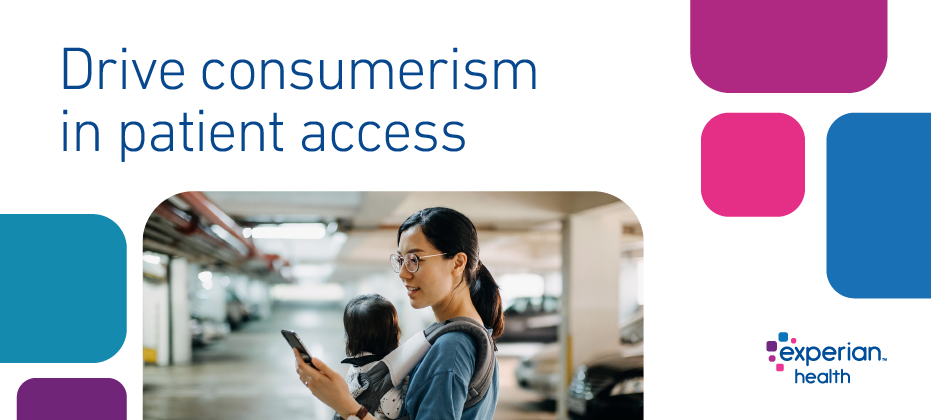Patient Access
Learn how to improve patient access by verifying critical patient information and collecting patient payments prior to service.

With a vaccine for COVID-19 thought to be at least a year away, healthcare providers are steeling themselves for even more cases in the fall. The big worry is that a surge in cases will hit the health system just as flu season takes hold. In a recent interview, Dr. Robert Redfield, Director of the Centers for Disease Control and Prevention (CDC), warned that “the assault of the virus on our nation next winter [may] actually be even more difficult than the one we just went through… we’re going to have the flu epidemic and the coronavirus epidemic at the same time.” Healthcare organizations are accustomed to an influx of sick patients between October and March: around 62,000 people died and more than 700,000 were hospitalized during last winter’s flu season. With 130,000 Americans losing their lives to COVID-19 in just four months, what could happen when the two respiratory diseases collide? Large numbers of patients with either virus (or potentially with both) will put renewed pressure on staff and services that are already under immense strain. Hospitals will need to prepare to manage both groups of patients as efficiently and safely as possible. Five ways to ease stress, paperwork and patient concerns ahead of a dual epidemic 1. Use data to drive your patient engagement strategy Create a flu preparedness patient engagement strategy to keep patients informed of how best to protect themselves in the context of a dual epidemic. As a result of the coronavirus pandemic, patients may be more familiar with telehealth services as a “contact-free” alternative to in-person appointments, so you’ll want to continue to promote these to minimize the spread of infection. With consumer data, you can segment patients according to risk and automate your communications, so they get the most relevant message at the most convenient time. 2. Relieve pressure on staff with automated patient scheduling Digital scheduling gives patients the option to book appointments online, at a time and place that suits them. This reduces pressure on call center staff and can give providers control over the volume and timing of in-person appointments, thus helping to reduce the spread of germs. An online patient scheduling platform can automate the entire scheduling process, integrating in real-time with your records management systems and connecting to your referral providers’ systems for a seamless patient and staff experience. 3. Screen patients proactively to discover their needs ahead of time Asking patients to fill out electronic questionnaires before their visit means their access needs can be identified and addressed before they come in. Do they need help to find transportation? Will they face any challenges in picking up a prescription? Is there something that could stand in the way of follow-up care? Screening for social determinants of health can answer these questions so you can direct patients to the most appropriate care and support. 4. Enable digital patient registration for a quick and easy intake experience Speed up the registration process by giving patients the option to complete their intake admin by phone or through their patient portal. Not only will this reduce the spread of infection in busy waiting rooms, it’ll make for a more enjoyable patient experience and free up limited staff resources for other priorities. With automated registration and consumer-facing mobile experiences, you can improve the patient experience, operational efficiencies and data accuracy all at the same time. 5. Minimize in-person interactions with contactless payments Encourage patients to clear their balances without having to hand over cash or access payment kiosks. Self-service digital payment tools allow patients to make contactless payments through their patient portal or from their mobile device. “The combined pressure from two viruses hitting health systems at once means it’s even more important for providers to leverage data for speed and accuracy. Automated workflows can help accelerate operational efficiency, as well as create a better patient experience during what’s already an extremely stressful time.” Victoria Dames, Vice President of Product Management for Experian Health Find out more about how Experian Health’s expertise in data and analytics can help your organization prepare for the coming flu season so you can offer your patients a safe, accessible and stress-free experience. We have also developed a checklist of action items for providers to consider as you prepare for both flu and COVID-19. How ready are you? Which actions is your organization instituting now?

For many healthcare consumers, visiting patient portals to check medical records, schedule appointments, renew prescriptions and pay bills is a no-brainer. Accessible from multiple devices at any time of day, patient portals allow patients to manage their health from the comfort and convenience of their own home. COVID-19 has been a catalyst for even more patients to consider remote and virtual healthcare services. But with large healthcare data breaches increasing by nearly 200% between 2018 and 2019, one concern continues to lurk in the background: how do providers keep patient data safe? Knowing the industry is prone to dated cybersecurity measures, hackers zero in on the lucrative medical identities market, with their top targets including: patient medical records billing information log-in credentials authentication credentials, and clinical trial information. As COVID-19 encourages more patients online, the digital doors are open for even more identity thieves to try to steal – and profit from – sensitive data. Healthcare organizations need to be confident that the person logging on is who they say they are, both to reduce the risk of a data breach and minimize HIPAA penalties. One way to balance consumer convenience with data security is to automate the patient portal enrollment process with robust patient identification protocols, making it harder for hackers to access patient information but without burdening patients. 2 ways to automate patient portal enrollment 1. Ditch activation codes that are easily misplaced Many healthcare organizations give new patients an activation code to use the first time they log in to their patient portal. Unfortunately, these tiny bits of paper or codes hidden at the bottom of lengthy enrollment documents are easily lost or forgotten. The patient has to call the office, taking up valuable staff time and resources to figure out how to log on – the opposite of streamlined and scalable. Instead, providers should consider an automated portal sign-up process. Using a combination of out-of-wallet questions, device recognition, risk models and cross-checks with linked patient data, portal access can be secured through a single platform. It’s easier and more reassuring for patients, and with far fewer calls to IT support. 2. Find quicker ways to integrate patient identity tools with existing systems The more people who need to see patient data, the more opportunities there are for cyber thieves to sneak in and access that sensitive information. Being able to share data securely between multiple providers and across different platforms is essential. During the current COVID-19 crisis, integrating authentication tools with other healthcare information systems (HIS) quickly is a huge advantage. One example is Precise ID, which can now integrate directly with Epic’s MyChart portal, Allscripts’ FollowMyHealth platform and many other HIS systems within two weeks. Jason Considine, senior vice president and general manager of Experian Health’s Patient Experience Solutions says: “Patients want to feel reassured that their data won’t wind up in the wrong hands. That’s even more important right now, as COVID-19 means more patients are choosing online services instead of face-to-face contact. With staff and cashflow under pressure, it’s even more important to get systems up and running as fast as possible. That’s why we’ve integrated with leading HIS systems to help them achieve interoperability within just two weeks.” Patient portals have the power to transform the healthcare experience for patients, but only if they can trust that their data will be kept safe. Providers can protect their patients from identity theft by adopting a multi-layered solution that incorporates best practice and cutting-edge data security technologies. Find out more about how Experian Health can help you automate patient portal security to avoid medical identity theft, so you can save money, avoid reputational damage and create a positive patient experience.

With COVID-19 leading to postponed and cancelled medical appointments, more consumers are turning to “contactless care”. Recent figures suggest telehealth adoption has shot up from just 11% in 2019 to 46% over the course of the pandemic, and some providers are seeing up to 175 times the number of telehealth patients than pre-COVID. As they grapple with the surge in patient volumes alongside regulatory change, many are playing catch-up. For patients, rushed implementation means the telehealth experience can fall short of expectations. Compared to the easy one-click services available with online retail and finance platforms, telehealth can feel clunky and frustrating. Technical issues, not knowing how to prepare for appointments, and a lack of awareness of available services can all taint the consumer experience. Providers looking to launch (or re-launch) a patient-friendly telehealth service ahead of a possible second wave should aim to check off these four considerations before rolling it out. 1. Prioritize easy online scheduling for virtual care Allowing patients to book telehealth appointments when it suits them will help to reduce no-shows and minimize delays. A telehealth platform that integrates with physician calendars and other patient management and record management systems will keep things running smoothly at the operational level, while creating a convenient and secure way for patients to schedule care. For example, when Benefis Health System implemented Patient Schedule, more than 50% of patients chose to book their appointments out of normal working hours. Sam Martin, digital developer and web specialist at Benefis, says: “If you’re not allowing your patients to schedule online, you’re behind the times. You can only benefit from it. We’re seeing the number of online bookings continue to grow every month, confirming that this solution is working for patients.” 2. Include quick and reliable coverage checks With the pandemic and resulting unemployment putting both provider and patient cashflow under strain, any available commercial or government coverage must be identified quickly. Providers should run automated coverage checks to find any missing coverage and select the right financial pathway for each patient as soon as possible. Not only will this create a more compassionate patient financial experience, it’ll allow the collections team to focus their attention on the right accounts and minimize the risk of write-offs. Automated Coverage Discovery screens for eligibility through Medicare, Medicaid or commercial plans, without any collections agency getting involved. With this tool, Essentia Health were able to find coverage for 16,990 accounts that were assumed to be self-pay or uninsured. Kathryn Wrazidlo, Patient Access Director, says: “This has helped patients because we’re actually billing their insurance versus billing them for self-pay. It’s helping staff because they’re billing the insurance company much quicker. There’s less rework.” 3. Get telehealth claims right first time Given that the pandemic may cost hospitals an estimated $200 billion between March and June 2020, there’s no room for the added financial burden of claim denials. But as telemedicine expands, so does its regulatory framework. Providers must keep track of changing payer updates and coding rules so that claims are submitted right first time. An automated, data-driven claims management tool can help providers analyze claims with greater confidence and spot any errors well in advance of submission. Telehealth alerts can be included as customized edits, to confirm whether the patient’s current plan includes virtual care. To help providers manage this process, Experian Health is offering free access to telehealth payer policy alerts through our COVID-19 resource center. 4. Protect patient data As with any part of the digital patient experience, a multi-layered approach to protecting sensitive information is a must. Ideally, this will include two-factor patient identity authentication, device recognition and out-of-wallet checks whenever a log-in attempt looks suspicious. Automating this process with a tool such as Precise ID allows providers to integrate multiple data points to check that a patient is who they say they are, in a way that’s HIPAA-compliant. This makes it harder for thieves to access patient data, without burdening the patient with extra checks as they manage their information. Retaining patient volume and rebuilding revenue through “contactless” care won’t be possible unless the entire telehealth journey is as seamless as possible. From scheduling to payment, Experian Health can help you create a virtual patient experience that’s convenient, secure and reliable. To learn more about how to build a better digital patient journey, download our free eBook.

Consumers today expect fast and convenient access to almost everything, healthcare included. While still only offered by a fraction of healthcare providers out there, online scheduling is catching on throughout the market – especially as more providers turn to telehealth solutions during COVID-19. Still, despite the uptick in online self-scheduling, there are patients who prefer to call to schedule an appointment and call centers may be overwhelmed as a large number of patients rush to reschedule appointments that were cancelled or postponed due to COVID-19. To best prepare, providers will want to ensure the best possible patient experience for those calling to schedule an appointment. This can be done by enabling online scheduling throughout the call center. Here are five ways to make patient scheduling easy through your call center: Save timeWith a manual scheduling process, patients often have to sit on the phone – sometimes for upwards of twenty minutes – while also being put on hold or having to wait to be called back to confirm an appointment. It’s not only an awful patient experience but imagine what all that time adds up with the number of scheduling calls providers receive every single day? By reducing call times you’re making the process more efficient for more routine scheduling calls while also opening up call center agents to focus on those patients who need more attention. Automate the rulesThe key to reducing time spent scheduling an appointment is automating the scheduling protocols and business rules of the providers in the scheduling platform. Call center agents traditionally have to manually navigate expansive spreadsheets or three-ring binders of business rules with the scheduling criteria for each provider. Experian automates all those rules in our system and translates them to easy Q&A prompts for the scheduler while on the phone with a patient. In short, rules automation equals quicker scheduling (while maintaining accuracy). Improve trainingBecause the rules are automated, the training process for call center agents is made much more efficient. Where agents would have had to learn the various nuances of scheduling complex specialty care for a variety of providers, they now just need to learn how to use the scheduling platform. The scheduling protocols are automated and help dialogues will pop-up to explain and guide agents through the scheduling process for every provider and care type. Where it may have taken 60 to 90 days to master scheduling for a new specialty, schedulers can now be experts for that specialty in as little as one hour. IntegrationIn order to get the most out of any scheduling solution it needs to integrate into the provider’s practice management system. Leveraging APIs or HL7 bi-directional connectivity, all bookings occur in real-time. This prevents any double-bookings and also removes any calendar maintenance by staff to block and recheck time for providers. With the integration, bookings from the call center transact the same as if a staff member was logged in at the providers office and scheduling on the spot. Automated outreachProviders can use automated outreach to augment their call center capabilities. With it they can send text message and IVR campaigns to patients with the ability for patients to schedule an appointment in real-time on the phone. Check out Patient Schedule to learn more or download our free guide about how scheduling can be made easier for your patients through all of your access channels.

Patients today expect digital capabilities from their provider and will increasingly choose those who offer digital capabilities. Knowing this, many providers have been working to shift more of the patient journey online, through telehealth and virtual care. Not all care needs to be delivered face to face, and technological advances allow patients to access more services from the comfort of their own homes, at a time that suits them. This trend has been visible for a few years now, as consumers sought out more smartphone-friendly digital healthcare experiences. But change in the healthcare industry often comes at a lumbering pace, so when the coronavirus pandemic hit and accelerated the transition to remote care, many organizations found themselves on the back foot. Now, it’s a case of catch-up, keep up or get left behind. As demand for telehealth services grows, so too does the regulatory framework around it. A big part of staying competitive will be the ability to keep track of new telehealth regulations and changing payer rules. Those that don’t will find their collections straining under the added pressure of missed reimbursement opportunities. How can providers stay on top of the changes and maximize reimbursement? Keeping track of telehealth reimbursement regulations Since early March 2020, the federal government has moved to make telehealth more accessible to patients with Medicare coverage. Limitations on the types of clinicians that can provide telehealth services under Medicare have been waived, while Medicare beneficiaries in rural areas and those with audio-only phones can now access care remotely. New telehealth services will be added to the reimbursable list under a quicker process, which is a huge benefit to both patients and providers, but will mean the rules around reimbursement could change more frequently. Speaking in March, CMS Administrator Seema Verma said: “These changes allow seniors to communicate with their doctors without having to travel to a healthcare facility so that they can limit risk of exposure and spread of this virus. Clinicians on the frontlines will now have greater flexibility to safely treat our beneficiaries.” Flexibility is always welcome – but what do looser rules mean for reimbursement workflows? Three challenges stand out: Payer variation. Telehealth and telemedicine data can be presented differently by different payers, causing a headache for providers during eligibility verification.Coding variation. Each type of telehealth visit is coded and billed differently. Regardless of where appointments are carried out, clinicians must still follow the same billing workflow, so keeping track of the differences is essential.Geographical variation. Providers now have to track billing and coding changes for telehealth services from different payers across multiple states. What can providers do to bill telehealth services as accurately as possible? Billing for telehealth services more frequently calls for a solution that’s flexible enough to keep pace with changing payer rules, and sufficiently scalable to provide real-time reimbursement information when it’s needed. Automation can help achieve both of these goals. Two use cases for automation: Quicker Medicare checks: Run quick and accurate checks to confirm patients are eligible for Medicare coverage for the services in question. A tool such as Coverage Discovery can comb for available coverage, even as patients are switching plans or payer rules are changing. In addition, eligibility verification automations can sweep for coverage information on telehealth services, using reliable and secure third-party data and analytics to check for updates. Cleaner claims submissions: Tighten up billing workflows so that claims can be submitted as soon as possible. Claims management software can run automatic checks so that every claim is submitted clean and error-free. Any missing or incorrect codes can be flagged up, eliminating costly and time-consuming rework. Telehealth alerts can be included as customized edits to confirm whether virtual care is a benefit included in the patient’s current plan. While these actions can help protect your bottom line during the immediate crisis, they’ll also help you build a solid foundation as your telehealth offering inevitably continues to grow. Whether you’re looking to verify coverage, check eligibility or protect patient identities as they log in and use telehealth services, reliable data is key. Schedule a free consultation to discover how Experian Health can help you leverage accurate and real-time data insights to optimize your billing workflow and maximize telehealth reimbursements.

From airlines to cafés to car manufacturers, businesses across America are scrambling to respond to the challenge of COVID-19. In healthcare, services are being put on pause to protect staff and patients on the pandemic’s front line, leaving health systems to contend with gaps in reimbursements and exhausted cash flows. The problem lies in the sheer number of human touchpoints involved in the typical patient experience: scheduling, paperwork, waiting rooms, treatment, payment…all that in-person interaction just isn’t realistic in the current climate. Digital and mobile technology could be the answer. While digital communication platforms have been growing steadily over the last decade, they’re now a life raft for many providers as COVID-19 forces much of the patient journey online. Megan Zweig, director of research and marketing at Rock Health, says investments in virtual care have already exceeded $3 billion this year: "Without COVID, the story would have continued from last year as this was a healthy, growing space with a lot of momentum behind it. That momentum has turned into incredible urgency and demand for communication, testing, monitoring, care – all of those things done at a distance." This trajectory will likely continue beyond the immediate crisis, as providers prepare for a possible second wave later in the year and patients become accustomed to remote and mobile options. Providers that take advantage of these digital solutions now will be better positioned to optimize the patient journey in a post-COVID world. What could the digital patient journey look like beyond COVID-19? A digital healthcare experience can offer patients more convenience and flexibility while protecting revenue for providers, in the following ways: Scheduling appointments when it suits The first bump in the road for many patients is scheduling their appointment. With many in lockdown juggling home-schooling and home-working, it’s not always convenient to call during office hours. A patient scheduling platform lets the patient book their appointment whenever suits, using the channel they prefer. Before the pandemic, Benefis Health System found 50% of patients chose to book after hours, including for urgent care. We can expect this to increase as even more patients are nudged online. As the threat of COVID subsides, a massive influx of patients will also want to reschedule postponed visits. Automated patient scheduling will reduce the pressure on call centers and offer a more efficient consumer experience. Reducing registration gridlock with automation Patient access is often rife with avoidable stress – queues, unnecessary forms and manual data entry, resulting in costly errors and repeated work. Instead, providers can streamline the process by allowing pre-registration tasks to be completed online, and automating patient access with a mobile intake experience. Completing as many tasks as possible outside of the provider’s office will help minimize face-to-face contact, keeping everyone safe. Opening up access to telehealth There’s no getting around the fact that most care needs to be delivered in person. Telemedicine offers an effective way for patients to seek care from the safety of their own home. Video calls can be used for general consultations, remote monitoring of patients with respiratory conditions, and even supporting patients with chronic conditions to adhere to care plans. As the government allocates $20 million to support access to telemedicine in response to COVID-19, up to 54% of patient encounters are expected to take place remotely in the near future. Many of these patients will choose to stick with telemedicine, even when in-person options return. [Remember to check out our free COVID-19 Resource Center, where you can get free access to telehealth payer policy alerts to help avoid payment denials and delays.] Making contactless payment the easy option Contactless payment through apps such as Apple Pay and Venmo are gaining popularity as consumers try to avoid exchanging cash and cards. But can it be used in hospitals? In short, yes. Not only does Experian Health’s Patient Financial Advisor offer patients a way to make secure – and socially distanced – payments, it allows providers to give a breakdown of estimated costs using real-time information. Patients get updates on their mobile or through their patient portal. These digital alternatives not only offer a more convenient patient experience, they can also allow providers to collect payments faster and in full. Contact us to find out how digital health solutions can help your organization adapt to the new normal, and provide a better patient experience now and beyond COVID-19.

The term “digital front door” is one of the biggest buzz words in healthcare, and thanks to COVID-19, we can expect to see it even more. Already, according to an Accenture survey, 77 percent of patients believe the ability to book, cancel, or change an appointment online is important. Now, with social distancing and stay at home orders in place, offering digital tools for engagement is more important than ever. But what exactly makes a strong “digital front door” and what does it take to create one? What precisely does a digital strategy need in order to better engage and retain patients? There are a lot of thoughts about what the digital front door looks like, from pricing transparency to ratings and reviews, reputation management, patient registration, and more. We know patients today are seeking greater transparency from their entire healthcare experience. Yet each of the qualities above reflect more of a digital billboard than an actual front door. After all, the front door needs to be a pathway to see a physician or access care; it must actually “open.” A true digital front door will do the following: Enable omni-channel access. Improving access begins with offering more channels for patients to find the care they need – a necessity today in the midst of COVID-19. Digital scheduling drives patient access, plain and simple, whether it be through call centers, automated outreach, or online self-scheduling. Omni-channel access not only opens the door for patients experiencing COVID-19 symptoms, giving them a fast and easy way to connect with a provider, but will be key for the post-COVID world when patients begin to reschedule those appointments that have been cancelled or deferred. Engage patients. Patients want convenience when it comes to accessing care. Now, more than ever, patients look online for information and expect to find what they need easily and quickly. Making service information available online, such as COVID testing, is an obvious first step. Allowing consumers to simply and efficiently book the care they need online will lead to increased engagement, as well. Improve productivity. More than half of all patients prefer to schedule outside of business hours. Digital scheduling can enable that, increasing appointments while improving provider workflow, freeing up staff to focus on other activities. This will prove critical as providers brace for an influx of patients seeking to reschedule appointments that have since been cancelled or deferred due to COVID-19. Additionally, automated reminders help improve patient show rates while data-driven practices help refine scheduling logistics. Increase revenue. Providing better, more efficient access, increases the number of patients coming into a practice – which means more revenue. And today, as a result of heroic efforts to serve communities impacted by COVID-19, providers are more strapped for revenue than ever before. With access to digital and mobile solutions, providers can attack revenue loss from two sides –attracting new patients and retaining current ones. Drive higher patient satisfaction. Faster, easier access to healthcare equals better satisfaction with the process of accessing healthcare, with the provider organization, and with the provider. And, if you really want a crowd pleaser that can also generate revenue, automated business rules and scheduling protocols are a must have.It’s the combination of convenience and effectiveness that keeps them coming back for future care needs – coming back, of course, through the digital front door. Learn more about how Patient Scheduling can help to unlock your organization’s digital front door.

The novel coronavirus pandemic crisis of 2020 has plunged the healthcare system, and frankly the whole economy, into a dark place. It will take time, and likely a lot of time, to overcome what may end up being several months of a national shut down. Eventually people will re-emerge from isolation, business will resume a new normal, and healthcare providers will turn their attention to the revenue generating services that they temporarily halted, as well as the patients who delayed care for a myriad of conditions. The Centers for Medicare and Medicaid Services (CMS) recently published “phase one” re-opening recommendations that recognized in some areas the possibility of non-COVID-19 care is already being considered. There will be an overflow of pent-up demand and provider organizations need to position themselves now to be ready. One consideration, with many health systems now feeling the squeeze and not being able to re-deploy staff to serve in the crisis, is to use some of those resources and prepare for the next phase. Here are few strategies to get ahead of the curve, if you will, as it flattens: Reschedule appointments – Literally hundreds of appointments– for some providers, thousands – that had been cancelled or delayed will require rescheduling. Deploying an omni-channel scheduling platform now can relieve the pressure of that future volume in several ways: Online scheduling can guide patients to the right care with rules automation, allowing patients to accurately self-book and reducing call center volume.Enable patient scheduling via automated outreach messages sent via text message or IVR. (For example, you can target all those who need to reschedule, reaching them via text campaigns and reducing call center workload).Reduce training time with a call center scheduling solution. Agents (such as temps hired to handle the influx of appointments) can be trained in a matter of hours to schedule and book appointments accurately.Harden your telehealth offering – This crisis has shown the necessity for virtual visit technology during a pandemic; however, its value won’t disappear as the crisis fades. Telehealth is destined to become a staple of healthcare delivery. Restrictions have been lifted and the technology has proven practical, convenient and efficient, paving the way for broad acceptance. But what are the digital complements that can be paired with telehealth to harden the solution and make the offering a robust tool into the future? While many providers are now able to offer this type of virtual care, scheduling across a variety of specialties has become a challenge. A tool that guides patients and call center agents to the right provider across all services, including telehealth, is going to be critical in the months ahead to maintaining scheduling efficiency and delivering an optimal patient experience.Establish your digital front door – Patients aren’t going to want only clinical telehealth options; the whole spectrum of patient-provider interaction is shifting. Scheduling, registration, payments - all these are going to see increased demand for digital self-service. This gets patients out of the waiting room and removes the need to swipe or insert a credit card or use a POS kiosk. Patients, who are consumers, want to use their mobile devices and they will form lasting opinions of those services enabling – or restricting – their ability to do that.Collections optimization – Right now the focus is on caring for patients, as it should be; however, in order to continue operating, providers must collect for the services rendered. Putting in systems that automate collections processes and reduce the human resources necessary to bring in revenue will to be key to capitalizing on the rush of non-COVID-19 care that will soon be required. These are just a few of the ways that healthcare providers can deploy digital technology to prepare and turn this looming challenge into opportunity. The reality is that managing patient engagement and collections through this next phase is critical to the U.S. healthcare ecosystem’s recovery. Organizations that emerge stronger will be those that prepare now and are ready when the time comes. Find out more about patient engagement solutions that can help you respond now and prepare for the future.

In today’s fast-evolving healthcare industry, consumer expectations are changing. Individuals are footing an increasing portion of medical bills, so they’re paying closer attention to their healthcare options. And with digital technology enabling choices for everything from where to bank to what to eat (and even who to date!), patients are now expecting a similar consumer-centric experience when it comes to their health. But what exactly are they looking for? Providers should respond to this rising consumerism with two things: convenience and engagement. Many patient tasks are time-consuming, tedious and repetitive. The use of outdated technology draws unfavorable comparisons with the intuitive apps used in other industries. And all too often there’s a one-size-fits-all approach to marketing. The opportunities to improve the patient experience are huge. As the competition for consumer business heats up, providers should look for ways to step up their patient engagement strategies to attract new consumers and inspire loyalty among existing members. Consider how to make it as easy as possible for patients to access the care they need, whether that’s through frictionless scheduling, simplified registration processes or proactive communication about free transportation options. Data-driven technology and automation can help drive improvements in both convenience and engagement. Here, we look specifically at how automation could help you meet changing consumer expectations in the world of patient access. How can automation make patient access more convenient for consumers? Patients hate administrative and financial tasks that take them away from family, friends and other priorities. When looking for an easy, streamlined patient access experience, they might ask: Can I make appointments online? Can I get an out of pocket estimate for my cost of care? And can I price-shop my services? Can I do my pre-registration work before I show up for my appointment? Can I manage my bills and all my health information online? Can I do all of this from my mobile or tablet device at a time when it’s convenient for me? Automation can help you deliver against these expectations and remove stress and hassle from many patient access tasks. By using consumer data and technology to trigger the next stage in the process, you can help patients navigate the complex healthcare system, making registration, billing and payment more convenient. For example, online self-scheduling lets patients plan appointments when it suits them. You’ll increase appointment and referral rates, improve call center efficiency, reduce no-shows and enhance the overall patient experience. Or how about offering patients a one-stop-shop for managing all their healthcare admin, through a digital patient portal? This makes it much quicker and easier for them to get price estimates, set up payment plans, update insurance information and stay on track with appointments and treatment plans. By automating the registration and billing processes, you’ll improve self-pay collections and decrease bad debt. If you can say “yes” to the above questions, you’ll be making life easier for your patient access staff too. Reliance on manual data entry processes means staff are constantly battling bottlenecks and dealing with avoidable errors and duplicate records. Not only does this waste employee time, it opens the door to major safety issues and lost revenue: patient identification errors can cost up to $2,000 per patient and are associated with a third of denied claims, costing the average hospital $1.5 million each year. How can automation support better patient engagement? This isn’t just about removing obstacles or introducing speedy tools. You can use automation to improve patient engagement at various touchpoints during the patient access process. Consumer data paired with automation can help you nudge patients by text or email to make appointments, so they don’t miss out on important checks. You can deliver personalized updates, reminders and offers, so your patients feel taken care of and know exactly what’s happening throughout their healthcare journey. Using lifestyle, demographic, psychographic, and behavioral data from the highest quality sources, you can also use automation to segment your audience into groups based on all sorts of variables, in order to communicate with them about the right services, at the right time. Now is the time to leverage technology for a better patient access experience. It’s clear that awareness of the potential ROI in automation is growing. Still, many providers have only scratched the surface when it comes to integrating automation within their revenue cycle operations. Given that 66% of patients would switch providers for more convenient access, it makes sense to consider how you can leverage technology to simplify all sorts of patient tasks, from pre-registration to payments. Learn more about how automation could help your organization create a better patient access experience for consumers.